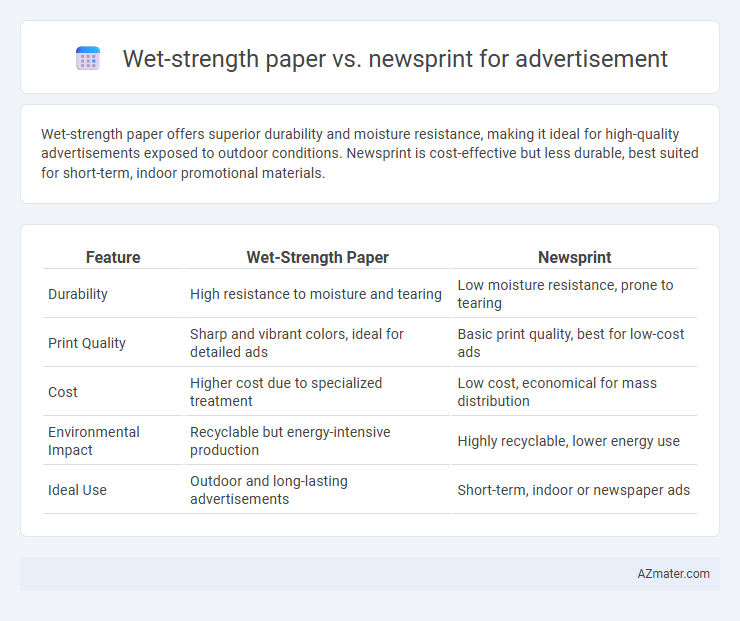Wet-strength paper offers superior durability and moisture resistance, making it ideal for high-quality advertisements exposed to outdoor conditions. Newsprint is cost-effective but less durable, best suited for short-term, indoor promotional materials.
Table of Comparison
| Feature | Wet-Strength Paper | Newsprint |
|---|---|---|
| Durability | High resistance to moisture and tearing | Low moisture resistance, prone to tearing |
| Print Quality | Sharp and vibrant colors, ideal for detailed ads | Basic print quality, best for low-cost ads |
| Cost | Higher cost due to specialized treatment | Low cost, economical for mass distribution |
| Environmental Impact | Recyclable but energy-intensive production | Highly recyclable, lower energy use |
| Ideal Use | Outdoor and long-lasting advertisements | Short-term, indoor or newspaper ads |
Introduction to Wet-Strength Paper and Newsprint in Advertising
Wet-strength paper, enhanced with chemical additives to resist tearing when wet, offers durability and longevity for advertising materials exposed to moisture, such as outdoor posters and product packaging. Newsprint, a cost-effective and lightweight paper made primarily from recycled wood pulp, is widely used for mass-distributed advertisements like flyers and newspapers due to its affordability and high printing speed. Choosing between wet-strength paper and newsprint depends on the specific advertising environment and the desired balance between durability and budget efficiency.
Material Composition: Wet-Strength Paper vs Newsprint
Wet-strength paper is manufactured using chemical additives such as resins or polymers that enhance its durability and resistance to tearing when exposed to moisture, making it ideal for outdoor advertisements. Newsprint, composed primarily of low-cost, mechanical pulp with minimal additives, lacks water resistance and tends to weaken or disintegrate upon exposure to humidity or rain, limiting its effectiveness in moist environments. The superior material composition of wet-strength paper ensures longer-lasting print quality and structural integrity in advertising applications compared to standard newsprint.
Durability and Longevity Comparison
Wet-strength paper exhibits superior durability and longevity compared to newsprint, maintaining structural integrity and resisting tearing even when exposed to moisture. This makes wet-strength paper ideal for advertisements requiring prolonged outdoor exposure or handling in damp environments. Newsprint, while cost-effective, generally fades and deteriorates quickly, limiting its suitability for durable promotional materials.
Print Quality: Color and Image Reproduction
Wet-strength paper offers superior print quality with enhanced color vibrancy and sharp image reproduction, making it ideal for advertisements requiring high visual impact. Its resistance to moisture prevents ink bleeding and smudging, ensuring consistent clarity and sharpness. In contrast, newsprint tends to absorb ink more readily, leading to muted colors and less precise image details.
Cost Efficiency in Advertising Applications
Wet-strength paper offers superior durability and moisture resistance, making it ideal for outdoor advertisements exposed to weather, albeit at a higher material cost compared to newsprint. Newsprint remains the most cost-effective option for large-scale, short-term campaigns due to its low production expenses and recyclability, despite its lower durability. Advertisers optimize budgets by selecting wet-strength paper for premium, long-lasting displays and newsprint for high-volume, disposable print ads.
Environmental Impact and Recyclability
Wet-strength paper, designed to resist tearing and maintain integrity when wet, uses chemical additives that can hinder recycling processes and increase environmental impact due to longer degradation times. Newsprint, commonly used for newspapers and mass advertising, is biodegradable and highly recyclable with a lower environmental footprint, making it a more eco-friendly option for advertisements. Choosing newsprint over wet-strength paper reduces chemical waste and supports more sustainable paper recycling systems.
Performance in High-Humidity or Outdoor Environments
Wet-strength paper retains structural integrity and print quality in high-humidity or outdoor environments, making it ideal for advertisements exposed to moisture or rain. Newsprint tends to absorb water quickly, resulting in smudging, tearing, and diminished visual impact under similar conditions. For durable, long-lasting outdoor promotional materials, wet-strength paper outperforms newsprint by maintaining sharpness and readability despite environmental challenges.
Suitability for Different Advertisement Formats
Wet-strength paper offers superior durability and resistance to moisture, making it ideal for outdoor and high-traffic advertisement formats like posters, banners, and flyers exposed to weather conditions. Newsprint is best suited for short-term, cost-effective print advertisements such as newspapers, brochures, and flyers where high image quality and longevity are less critical. Choosing between wet-strength paper and newsprint depends on the required durability, print quality, and the environment in which the advertisement will be displayed.
Brand Perception and Audience Impact
Wet-strength paper offers superior durability and moisture resistance, enhancing brand perception by ensuring advertisements remain crisp and legible in various environments. Newsprint, while cost-effective and widely distributed, often appears lower quality due to its thinner, less durable nature, which can diminish the perceived value of the advertised brand. Audiences typically associate advertisements printed on wet-strength paper with premium quality and reliability, resulting in stronger engagement and a more positive brand impression.
Choosing the Right Paper for Effective Advertising
Wet-strength paper offers superior durability and water resistance, making it ideal for advertisements exposed to moisture or outdoor conditions, ensuring the message remains clear and intact. Newsprint, while cost-effective and widely used for mass distribution, lacks durability and can easily smudge or degrade, potentially diminishing ad quality and impact. Selecting the right paper depends on the advertisement's environment and intended lifespan, where wet-strength paper enhances longevity and visual appeal for lasting brand impressions.

Infographic: Wet-strength paper vs Newsprint for Advertisement
 azmater.com
azmater.com